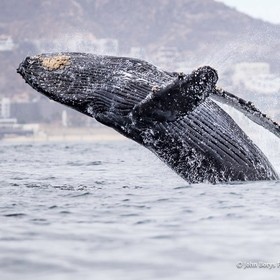Silt billows around this 14-foot hammerhead shark in the Bahamas.
Silt billows around this 14-foot hammerhead shark in the Bahamas.
Read less
Read less
Views
439
Likes
Awards
Runner Up in Giant Beasts Photo Contest
Staff Favorite
Categories
Same photographer See allBehind The Lens
Discover more photos See all
Behind The Lens
Location
This photo was taken about 40 feet/12 meters underwater in Bimini, Bahamas. I was on a Live-aboard called the Dolphin Dream and we were executing about four dives per day.Time
The time of day was mid-day. The visibility underwater was clear, but the activity of sharks and humans created a silt cloud that drifted up off the bottom a few feet. This reminded me of old rock videos with fog machines. This girl emerged from the cloud of silt just like a rock star and flashed a big grin.Lighting
The shark is lit with ambient light as well as two Ikelite DS230 strobes. Getting lighting right underwater is very different than lighting above it. Light falls off much sooner and the subjects are moving constantly. You also have to account for "backscatter" or particles in the water so the strobes must be positioned in a way that minimizes the amount of particles that are illuminated.Equipment
I shot this with a Canon 1D X MKIII, a Canon EF 16-35mm F/2.8L lens, a Nauticam Housing with a 230mm 9-inch dome port, and two Ikelite DS230 strobes.Inspiration
I fell in love with sharks at a very young age. I have always wanted to see them in their natural habitat. As an adult, I have had The opportunity to dive with sharks. Once I became aware of how much they are hunted and killed - 100 million sharks are slaughtered by humans each year, I decided I wanted to use photography to show how magnificent these animals truly are. I want to help show the world what I have seen in my nearly 500 shark dives: Beautiful, intelligent animals, who are very picky about what they eat. Not mindless killing and eating machines. Sharks are critical to the health of our planet. Without them, we will lose the oceans. Without the Oceans we will lose the Earth. We MUST protect them and stop the horrific devastation we are inflicting on the shark populations world-wide. Our Children's lives depend on it.Editing
I always try to clean up backscatter and the spots on my camera sensor that this particular camera seems to introduce frequently no matter how many times I send it back to Canon for cleaning and service. I will color correct because water affects color dramatically the deeper you go. I also remove water spots that can end up on the dome port.In my camera bag
When photographing underwater you can't change lenses or bodies very easily. The housing is built specifically for that model camera so swapping out bodies is not an option. The housing is vacuum sealed so changing the lens on a dive boat is a risky endeavor. So changing lenses almost never happens. I do carry extra batteries, a soft cooler to carry the camera, strobes and housing in that doubles as a rinse tank. And a white balance card. In addition to my Ikelite strobes, I carry a backup set of strobes (Sea & Sea YS-D3 MKIIs), and Keldan video lights for videography.Feedback
First, learn how to dive and dive very well. Buoyancy control is crucial and diving can be a dangerous sport, especially when diving with sharks. Situational awareness is a must and something most new divers lack. Never take your camera underwater when diving with brand-new dive equipment or in a place with conditions you have not encountered before (drift diving, deep dives, etc,.). Once you are experienced diving, take your camera into very shallow and safe situations until you are comfortable with it before you bring it with you on more challenging dives. Always remember: the most important part of underwater photography is getting back onto the boat (or land) safely.
















































